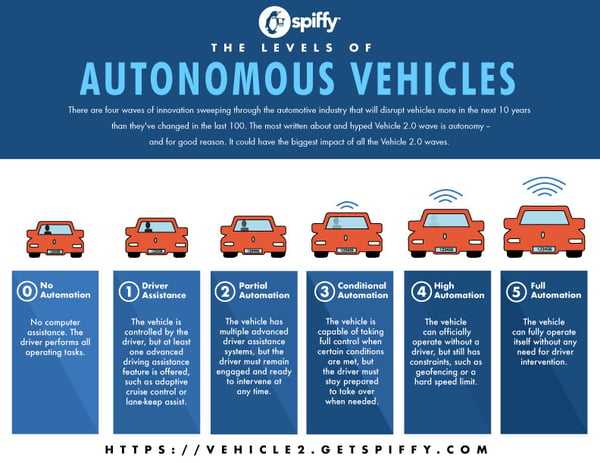It’s a safe bet that you’ve seen a headline or heard something about “self-driving cars” in recent months. Autonomy is simultaneously the most important and unpredictable of the four major waves of innovation that we’ve discussed on the Vehicle 2.0 Podcast.
Whether you’re still in the dark about autonomy or are looking to add to your existing knowledge, let’s dive more into the current state of the autonomous vehicle landscape with a helpful infographic.

In order to understand where automakers, software companies, and other contenders in the autonomy space currently are in their respective initiatives, it’s important to know the “Levels of Autonomous Vehicles”. There are six levels in total, ranging from no automation to completely self-driving cars.
Level 0, No Automation
No computer assistance. The driver performs all operating tasks. Even if you drive a car with a feature such as Automated Emergency Braking, you’re still operating a Level 0 vehicle.
Level 1, Driver Assistance
The vehicle is controlled by the driver, but at least one advanced driving assistance feature is offered, such as adaptive cruise control or lane-keep assist. The average driver of a vehicle higher than Level 0 leases or owns a Level 1 vehicle.
Level 2, Partial Automation
The vehicle has multiple advanced driver assistance systems, but the driver must remain engaged and ready to intervene at any time. Currently, this is the level of autonomy where most automakers are developing technology. Tesla has been a popular name in Level 2, but their recent news shows that they won’t be happy until Level 5 is achieved.
Level 3, Conditional Automation
The vehicle is capable of taking full control when certain conditions are met, but the driver must stay prepared to take over when needed. Level 3 gets more interesting and difficult for developers, as the vehicle has to monitor its environment in order to take full control, which requires some form of LiDAR or 3D camera imaging. Currently, it’s common for Level 3 vehicles, such as the Audi Traffic Jam Pilot, to be subject to a strict speed limit.
Level 4, High Automation
The vehicle can officially operate without a driver, but still has constraints, such as geofencing or a hard speed limit. Both Google’s Waymo and GM’s Cruise programs have been operating in Level 4 for some time now, with the latter having its sights set on mass production for ride-sharing in the near future.
Level 5, Complete Automation
The vehicle can fully operate itself without any need for driver intervention. There has been plenty of debate over how realistic Level 5 automation can be, especially depending on how and where it is implemented. This is the ultimate goal of autonomy, with Google and GM acting as the companies who are closest to achieving it.

While most of the automotive industry is still navigating past Level 2, the realistic use-cases for higher levels range from robo taxis and shuttles to entire cities revolutionizing their traffic infrastructure with fully autonomous vehicles for ride-sharing purposes. As the technology behind autonomy continues to evolve, there are certainly many more uses that will come to light as the industry reacts and adapts to such sweeping changes.
As always, be sure to stay tuned into the Vehicle 2.0 Podcast to hear the latest news regarding autonomy, electrification, connectivity, and shifting ownership models, as well as thought leadership from many different parts of the automotive industry!
Posted in Vehicle 2.0




